



Offshoring and Labor Demand Rosario Crinò Institut d’Analisi Economica, CSIC WTO-ILO Workshop on Global Trade and Employment Geneva, August 31 – September 1, 2009
Outline of the presentation My recent work on service offshoring 1. Possible directions for future research 2. Data issues 3.
Service Offshoring and White-Collar Employment Increasing attention to the labor market implications of 1. service offshoring during the last decade (Amiti and Wei, 2005; Baldwin, 2006; Mankiw and Swagel, 2006) Services, white-collar jobs and previous waves of offshoring 2. (Feenstra, 1998, 2007, 2008; Feenstra and Hanson, 2003; Hijzen, 2005; Crinò, 2009a) Potential heterogeneity in the effects of service offshoring 3. across white-collar occupations: Skills and Tradability (Bhagwati et al., 2004; Deardorff, 2005; Markusen, 2005; Grossman and Rossi-Hansberg, 2008; Markusen and Strand, 2008) This paper empirically investigates how skills and tradability 4. characteristics influence the employment responses of highly detailed occupations to service offshoring
Service Offshoring and White-Collar Employment Data Occupations Employment and wage data for 112 U.S. occupations (58 of them are white-collar) in 144 industries between 1997 and 2006 (from Occupational Employment Statistics) Skill level of each white-collar occupation proxied using Census data Degree of tradability proxied by quantitative indices (constructed using the O*NET data set) of: Involvement in routine cognitive tasks (Autor et al., 2003; Levy and Murname, 2006) Dependence on ICT (Garner, 2004) Degree of face-to-face interaction (Blinder, 2006, 2007) Service offshoring Share of imported private services in total non-energy input purchases (Amiti and Wei, 2005), proxied using 1997 Import Matrix and data on service imports from Bureau of Economic Analysis
Service Offshoring and White-Collar Employment Empirical approach Derive the demand functions for all occupations imposing 1. only mild restrictions on the relationship among them Flexible and Separable Translog (FAST) technology conditioned on service offshoring (extension of Fuss, 1977) Estimate the demand functions accounting for censoring in 2. the employment variable Quasi-Maximum Likelihood Estimation of panel-data censored demand systems (Mayerhoefer et al., 2005) Relate the estimated labor demand elasticities with respect to 3. service offshoring to the proxies for skills and tradability
Service Offshoring and White-Collar Employment Results Service offshoring is skill-biased, because it raises 1. employment in more skilled occupations relative to less skilled occupations For a given skill level, service offshoring penalizes 2. occupations with stronger tradability characteristics relative to less tradable occupations
Possible directions for future research How many jobs will be offshorable? 1. (Bardhan and Kroll, 2003; Jensen and Kletzer, 2005; Blinder, 2007; Van Welsum and Vickery, 2007) Western European and other developed countries 2. (Amiti and Wei, 2005; OECD, 2007; Crinò, 2009b) Polarization 3. (Goos et al., 2009)
Possible directions for future research Firm-level analyses 4. (Gorg and Hanley, 2005; Hijzen et al., 2007; Crinò, 2009c) Effects on individual employees and adjustment costs 5. Industry- or economy-wide-level data on service offshoring (Geishecker and Gorg, 2008; Liu and Trefler, 2008) Firm-level data on the foreign activities of MNEs (Becker et al., 2007; Becker and Muendler, 2008; Ebstein et al., 2009)
Data issues Official industry-level panel data on service imports 1. United States, since 2002 with limited industrial breakdown Western European countries, only for 1995 and 2000 United Kingdom (Geishecker and Gorg, 2008) Geographic breakdown of service imports 2. United States, unaffiliated transactions (Liu and Trefler, 2008)
Data issues Task- and occupation-level measures of offshoring 3. (Ebstein et al., 2009; Goos et al., 2009) Worker-level measures of job tasks and offshorability degree 4. (PDII: Blinder, 2008; Autor and Handel, 2009)
Service Offshoring and White-Collar Employment Results Table 9 - Service Offshoring, Skills and Tradability: Probit Marginal Effects Dependent Variable: Dummy for Positive FAST Elasticities ( DPOS n ) (1) (2) (3) (4) (5) (6) (7) (8) (9) (10) (11) (12) High skilled dummy 0.366** 0.598*** 0.570*** 0.531*** 0.620*** 0.493*** 0.489*** 0.472*** 0.366** 0.736*** 0.861*** 0.769*** [0.148] [0.173] [0.151] [0.168] [0.140] [0.162] [0.161] [0.157] [0.148] [0.154] [0.125] [0.147] Medium skilled dummy 0.138 0.220 0.214 -0.047 0.252 0.232 0.208 0.118 0.138 0.307 0.436 0.351* [0.166] [0.187] [0.178] [0.246] [0.184] [0.187] [0.176] [0.165] [0.167] [0.204] [0.292] [0.200] Tradability index -0.224** [0.100] Routine cognitive 1 -0.174** -0.217** [0.086] [0.085] Routine cognitive 2 -0.681*** -0.522** [0.132] [0.219] Routine cognitive 3 -0.220*** -0.254*** [0.080] [0.081] Interaction with PCs -0.169** -0.181* -0.389** -0.173* [0.085] [0.105] [0.178] [0.096] Face-to-face 1 0.130 [0.084] Face-to-face 2 0.135* 0.060 0.089 0.065 [0.077] [0.089] [0.105] [0.088] Face-to-face 3 -0.001 [0.073] Obs. 58 58 58 44 58 58 58 58 58 58 44 58 Results based on the elasticities in Table 6, panel a). Robust standard errors in brackets. ***, **, *: significant at 1, 5 and 10 percent level, respectively. All specifications include a dummy equal to 1 for the elasticities that are not statistically significant.
Recommend
More recommend